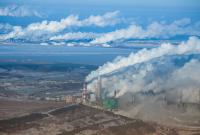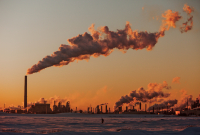Prime Minister Justin Trudeau is offering to exempt a large chunk of Alberta’s oilpatch from new environmental legislation if newly-minted Premier Jason Kenney sticks to a cap on annual pollution introduced by former premier Rachel Notley.
The Trudeau government proposed the exemptions on Wednesday as part of a new discussion paper that recommends what types of industrial projects would be subject to federal environmental assessments.
The federal government has long been suggesting that a specific category of oilsands projects, known as in situ, would be exempt from the environmental regime, thanks to the cap proposed by the Notley government to limit annual pollution from the oilsands to 100 megatonnes per year.
The oilsands are Canada’s fastest growing source of greenhouse gas emissions, making them a key sector to tackle if the country wants to meet its international climate change commitments under the international Paris Agreement.
The Notley government had introduced the cap on annual pollution for the entire oilsands sector as part of its overall climate change plan.
Despite the proposed federal exemption, the Trudeau government’s legislation also allows the federal environment minister to put any project onto the list if they feel it warrants more scrutiny and a full assessment.
But it also sought to tread lightly on issues of jurisdiction, which are the bones of contention in several court appeals provinces have lodged against Ottawa over its climate change policy.
A spokeswoman for federal Environment Minister Catherine McKenna said that the proposal reflects a commitment to recognize Notley’s cap as part of of a national climate framework, agreed to by Ottawa, the provinces and territories in 2016.
The Liberal government of Trudeau faces an October election just as Kenney, a former Harper minister, becomes premier of oil-rich Alberta. It proposed the exemption as part of a discussion paper released about the types of projects that would be subject to federal environmental assessment as part of its updates to Canada's environmental laws.
McKenna’s spokeswoman, Sabrina Kim, said that the environmental effects of projects that are not added to the project list would continue to be addressed by other regulatory regimes.
“Let’s be clear - every project developed in Canada will subject to the measures of Canada’s climate plan,” she said.
That includes methane regulations, a clean fuel standard, a price on carbon pollution, the phase out of coal by 2030, as well as provincial laws and regulations, she said.
Kenney has vowed to undo many of Notley's climate change policies, including Alberta's tax on carbon pollution, although he noted, following his swearing-in on Tuesday in Edmonton, that the industry was "nowhere close" to hitting the cap, and that his government hadn't committed to amending the provincial legislation.
The new federal legislation and list proposes to reverse a series of changes adopted by the former Harper government in 2012 that eliminated federal reviews for thousands of industrial projects.
Alberta's oilsands industry, which extracts the vast majority of Canada's energy exports, released 80.5 megatonnes of carbon dioxide equivalent in 2017, according to the federal Environment Department. The federal government estimates that the sector released 15.5 megatonnes of carbon dioxide equivalent emissions in 1990.
The most recent figures also show that annual oilsands pollution now exceeds the total greenhouse gas emissions of provinces such as Quebec, which released 62 megatonnes of carbon dioxide equivalent pollution in 2017 or British Columbia, which released 78 megatonnes of carbon dioxide equivalent pollution in the same year.
The oilsands pollution comes from three categories: oilsands mining and extraction; in situ oilsands; and oilsands upgrading.
The federal offer is to exclude in situ oilsands, which refers to oilsands extraction without mining where steam is injected into the ground to force bitumen out through a pipe.
In-situ extraction projects, like the one at Cenovus Energy's Christina Lake operation, could have less local environmental impact than open pit mines with tailings ponds but could also require more energy and thus higher emissions.
The government is proposing the exemptions as its scientists review whether in situ oilsands sites are accurately reporting their annual greenhouse gas emissions. The federal scientists released a study in April that found several oilsands mining facilities were, in fact, polluting much more than what they had reported.
Trans Mountain expansion would be exempt, says environmental lawyer
An Ottawa lawyer who worked for the federal environmental assessment agency in the 1990s when the original legislation was developed in 1995, says that the Liberal government's new list appears to be heavily influenced by the Canadian Association of Petroleum Producers and other oilpatch lobbyists.
"The proposed project list was written by CAPP and industry friends," said Stephen Hazell, the director of policy and general counsel at Nature Canada.
"Trans Mountain if proposed today likely would not be subject to federal assessment because it is (mainly) built on an existing right of way," he said.
Oilsands mines will be included regardless of the cap.
CAPP declined to comment on the federal proposal or the suggestion it had influenced what ended up on the list.
Facilities on the list are considered the biggest environment risks in areas of federal jurisdiction because of their greenhouse gas emissions and negative effects on fish.
The proposal lists a string of project types that would be carefully examined, including any;
new in situ oil sands facility with a bitumen production capacity of at least 2,000 cubic metres per day and major expansions of existing in situ operations (unless otherwise covered by a legislated hard cap)
new oil sands mine with a bitumen production capacity of 10,000 m3 per day or more
new oil refinery, including heavy oil upgrader, with an input capacity of 10 000 m3 per day or more and major expansions of existing refineries
new sour gas processing facility with a sulphur inlet capacity of 2 000 t/day or more, or major expansion of the same
new natural gas liquids storage facility with a storage capacity of 100 000 m3 or more, or major expansion of the same;
new international or interprovincial oil or gas pipeline, other than an offshore pipeline, with a length of 75 km or more in new right of way.
new marine terminal designed to handle ships larger than 25,000 DWT or expansion to existing terminal.
Hazell said the proposed list would mean that no assessment for in situ projects and fewer for pipelines and coal mines.
“The proposed project list is even weaker and shorter than Harper’s project list in 2012,” he said.
The list also adds offshore wind facilities with 10 or more turbines, and decreases the threshold for tidal power generation.
Editor’s note: Article updated at 4:59 EDT to include comment from office of the federal environment minister, Catherine McKenna, details of other projects included on the list.






Comments
Pure theatre. Oilsands emissions do nothing but climb year after year. Both levels of govt are complicit in Big Oil's plan to fail. The oilsands industry has the green light to expand indefinitely.
Notley's oilsands cap was just a fig leaf. Part of a cynical ploy to gain social license for new pipelines.
The 100+ Mt oilsands cap is 43% higher than current (under-reported) levels. Numerous exemptions boost the cap. The NDP left office without implementing regulations for the cap. The cap was never going to survive a NDP govt, and Notley knew it. Just a diversion.
Cynical petro-politics.
The oilsands industry is far closer to the cap than previously believed. Oilsands emissions (of all types) are grossly under-reported.
You can't manage what you don't measure. Although govts have known about the oilsands reporting issue for years, they have done precisely nothing to manage the problem.
Total oilsands emissions including projects that are under construction, have received approval, or are seeking approval "blow well past" AB's fraudulent cap. (Pembina Institute)
Trudeau should have the guts to tell Kenney: Pay Canadians the $260 billion Alberta owes for cleanup of its orphan wells first, then we'll talk!
From: Sloughing off the costs of environmental damage
By Ross Belot in Opinion, Energy, Politics | April 3rd 2019
".....It’s clear that the Alberta Energy Regulator (AER) and its predecessors have not looked after the public interest in this area, allowing industry to push out a large problem and it now is everyone’s problem to solve. The Alberta government in 2017 announced a $235 million loan to industry to deal with the problem of orphan wells. That is a drop in the bucket and an example of industry externalizing responsibility to government.
The Trudeau Liberals also gave $30 million dollars that same year to cleanup orphan wells in Alberta
Some estimates put the cost of abandoned wells at about $47 billion, citing Orphan Well Association estimates that it costs an average of $304,448 to reclaim a well.
The Alberta Energy Regulator has publicly stated that the cost of liabilities for provincially-regulated operations and facilities, including oilsands tailings ponds and pipelines is nearly $60 billion. The true cost could be as high as an estimated $260 billion, internal regulatory documents have warned."
Perhaps if Alberta is allowed to discontinue transfer payments the money saved can be used in the Alberta environmental clean up.
The Govt/Province of AB contributes $0 to equalization (transfer payments).
Equalization payments are funded by taxpayers, not provinces.
Wealthy taxpayers contribute most to tax revenues -- and therefore to equalization. Most wealthy taxpayers live in Ontario and Quebec. AB taxpayers contribute around 16% of equalization.
If equalization ended today, the Govt/Province of AB would be none the richer.
Mr. Kenney is quoted saying " Canadians need to realize the true value of Alberta's resources".
The total utter hypocrisy is blatant. The vast lakes of toxic sludge that the tar sands production have created are not valuable. Let's stipulate that the pipeline will be licensed as soon as the AER and the Alberta government guarantees the tailings ponds and abandoned wells have been decommissioned and certified reclaimed.
That all toxins produced are captured and filtered and not dumped into open pits strewn throughout the province.
How is it that Mr. Kenny can pursue only one avenue of development when the government of Alberta has been completely ignorant of the lakes of toxic waste that are accumulating in the tar sands?
The "discharge" of heavy metal laden water that is deemed to poisonous to be handled or released into the same rivers it was originally pulled from. Clean water collected and then "discharged" as chemical waste, a great way to shutdown any companies operation.
"We can't leave it in the ground." Justin Trudeau.